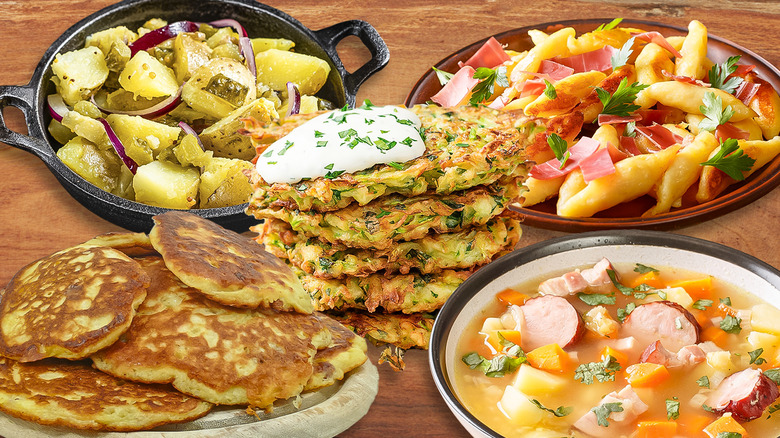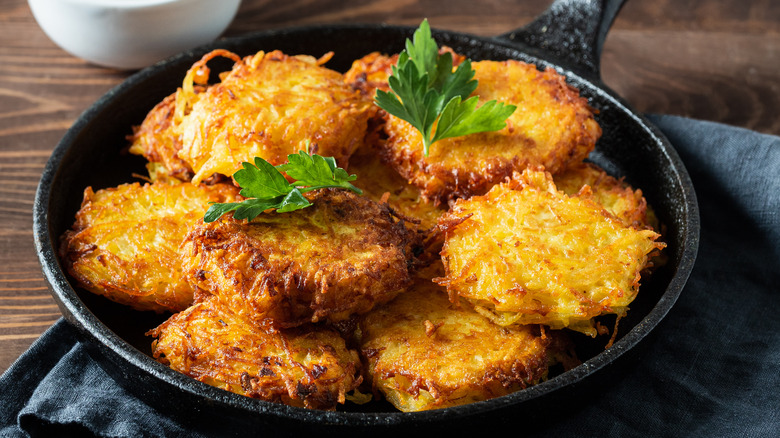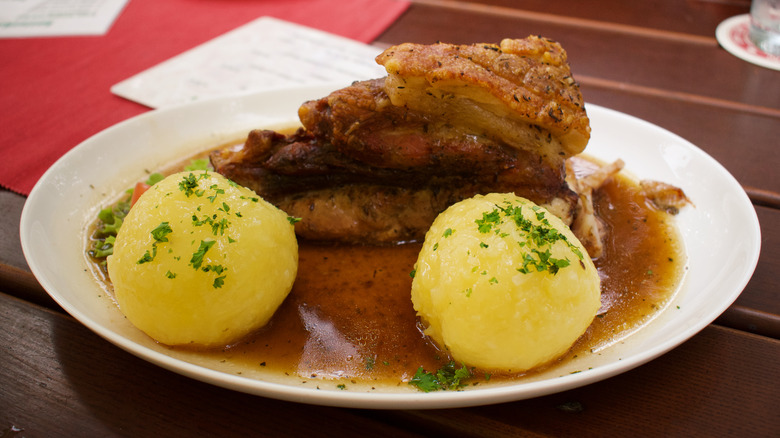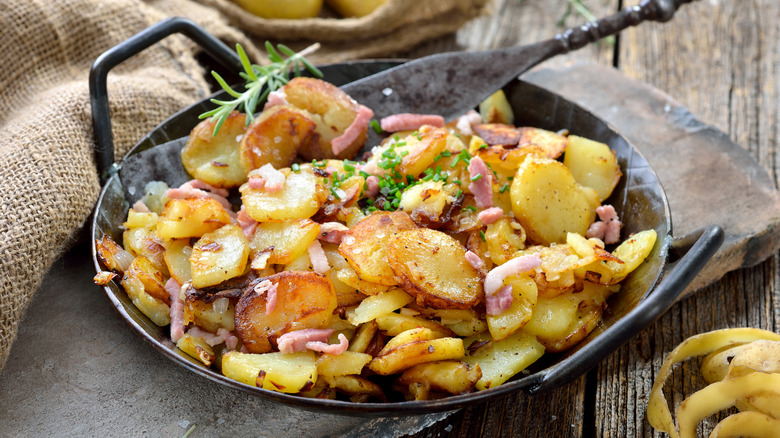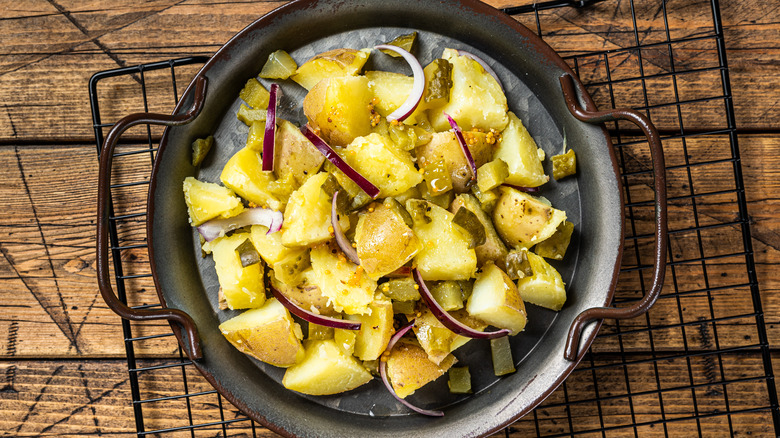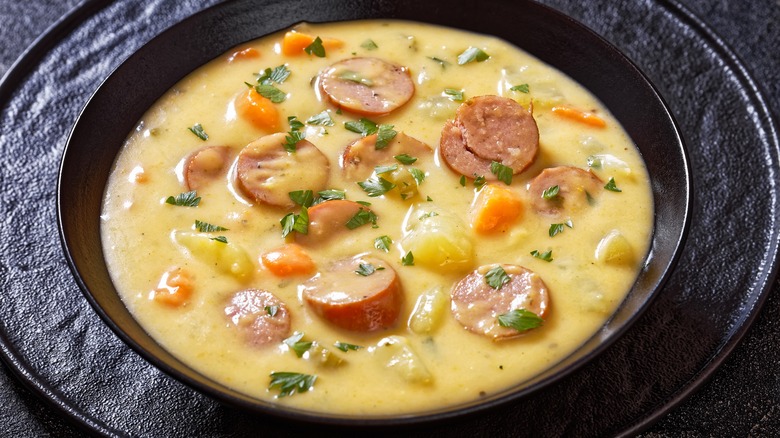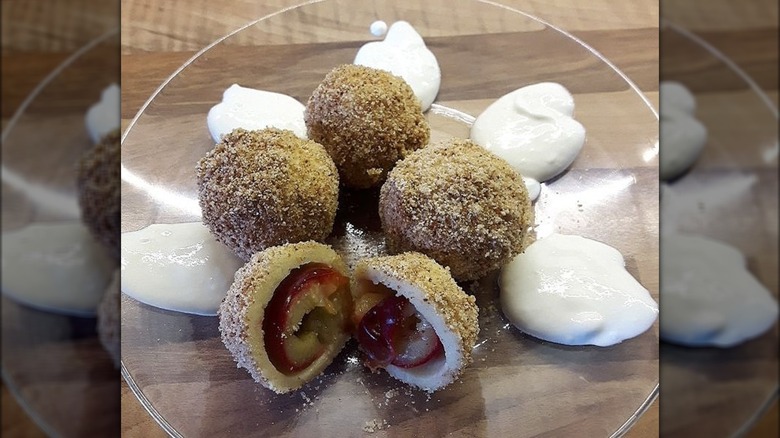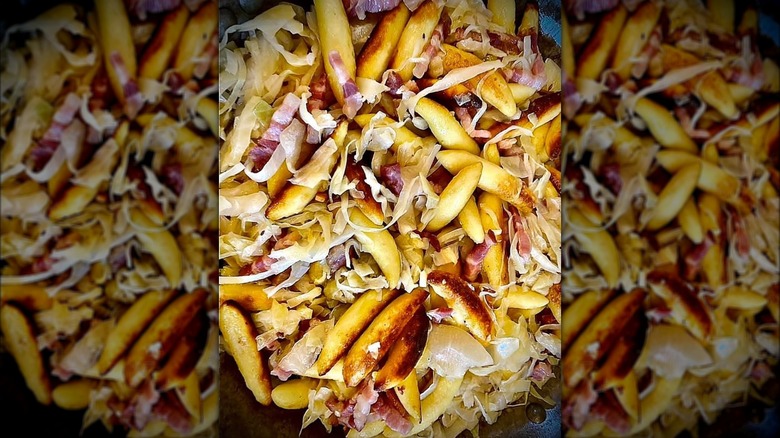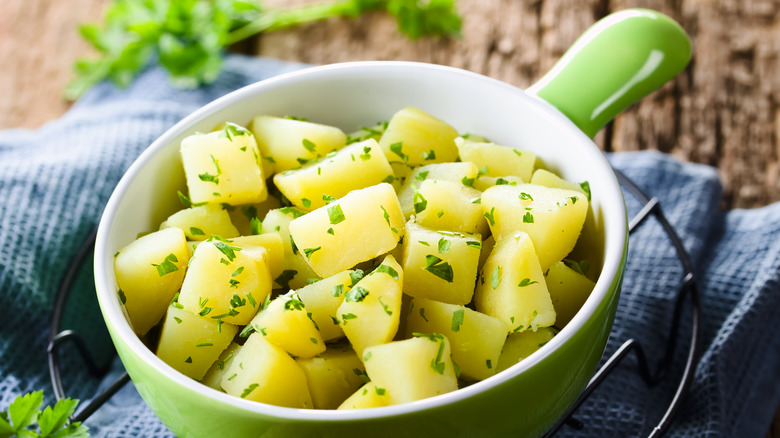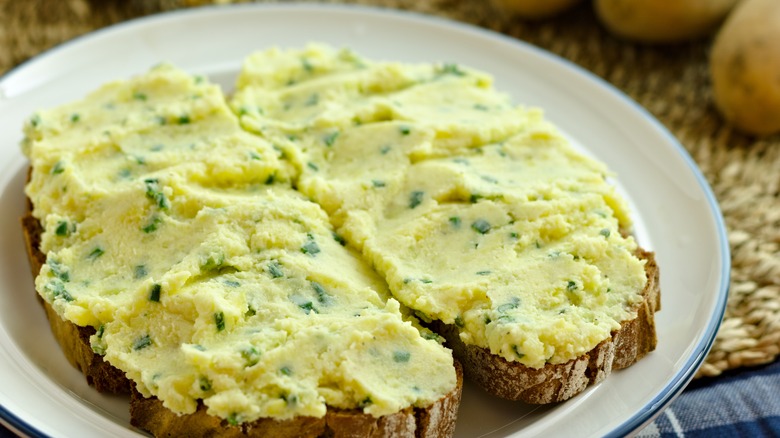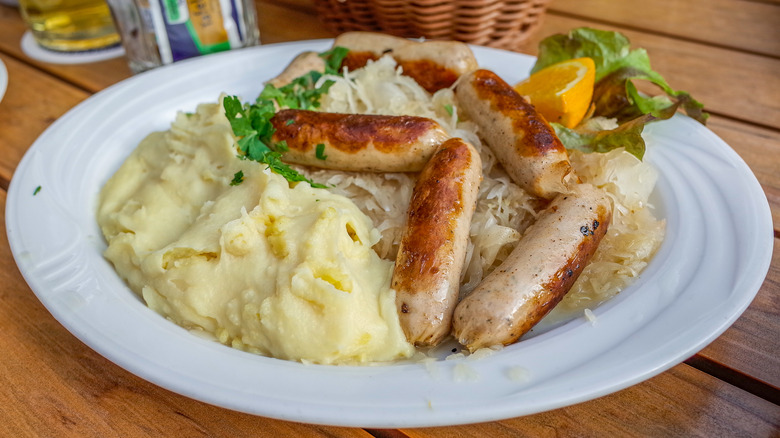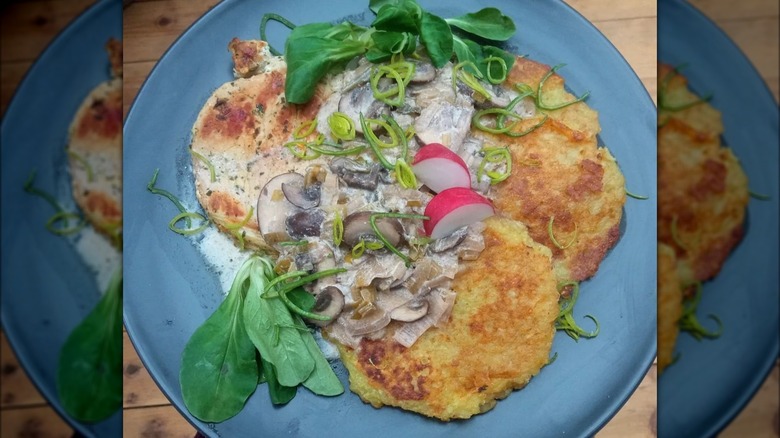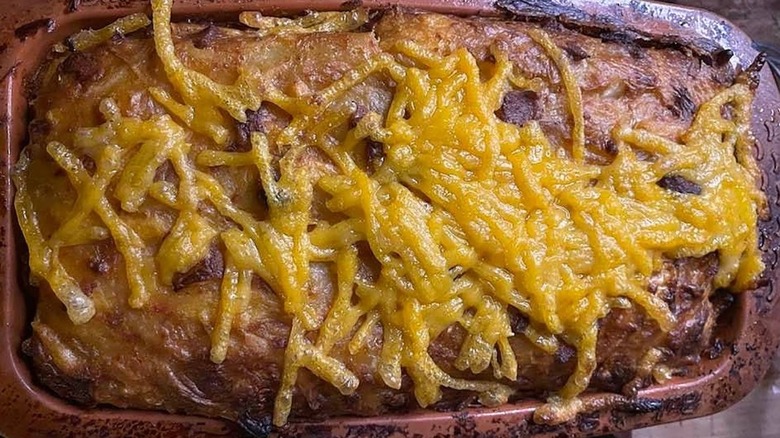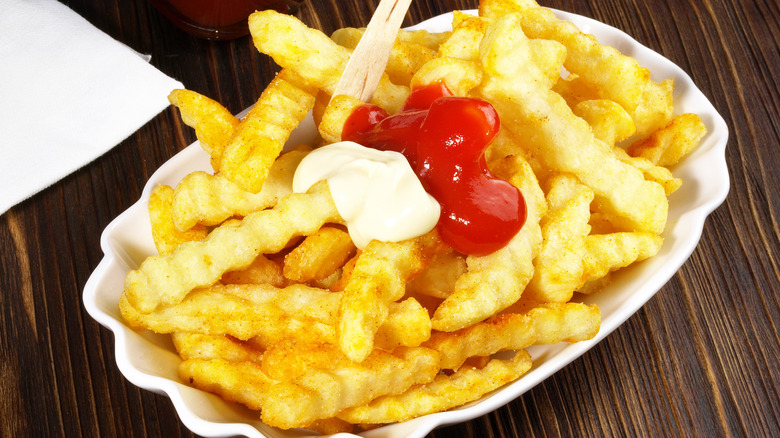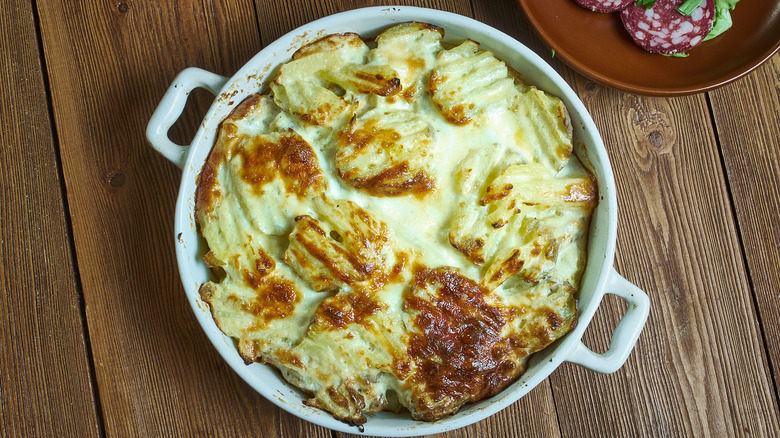14 Potato Dishes From Germany You Should Try At Least Once
Germany is well-known for its sausages and pretzels, all washed down with a foamy brew. While the country excels in those savory bites, its cuisine features a generous amount of potato-heavy dishes. That has not always been the case, though; this hunger for the humble tuber was inspired by necessity.
In the 18th century, the region now known as Germany was faced with a famine. King Frederick the Great knew he had to find a way to convince the population to consume potatoes, a crop still new to Europe and unpopular in Germany. The king was successful, and potato-centric meals became increasingly common. From fluffy mashed potatoes to crispy potato pancakes and countless options in between, even potato-neutral folks will find something to love in the local variety.
Whether you book a flight to go taste these dishes for yourself or DIY at home with a recipe and your favorite imported German beer, the outcome is sure to be positive. Here are the potato dishes from Germany you'll want to make a point to try at least once.
Kartoffelpuffer (potato pancakes)
If your idea of a pancake is fluffy and dripping with maple syrup, Germany's version is a whole new beast. Kartoffelpuffer (aka Reibekuchen, Kartoffelpfannkuchen, or potato pancakes) is more akin to a fritter than a pancake in the traditional sense. Made with grated potatoes, finely chopped onions, and eggs and flour to bind, the result is delightfully crispy after being fried in hot oil. The golden snack offers an earthy flavor profile with subtle sweetness from the onions. If you're a fan of fried potatoes in any format, you'll love this variation.
Thanks to the pancake shape and basic ingredients, there are lots of ways to serve Kartoffelpuffer. Enjoy the pancakes as a starchy side, or serve them straight up as the star of the meal. Traditionally, Germans love adding a dollop of applesauce or plum compote and serving them as dessert or combining sour cream and smoked salmon for a gourmet touch. Alternatively, the crispy fried treat is an excellent way to round out a meal of German bratwurst and sauerkraut. Keep an eye out for these crunchy pancakes at Christmas markets in Berlin, as they are the perfect comfort food for a cold winter day.
Kartoffelknödel/Kartoffelklösse (potato dumplings)
Forget about Asian dumplings for a second and discover German potato dumplings, also called Kartoffelknödel or Kartoffelklösse. These small orbs are a classic dish in both German and Austrian cuisine, and the hearty recipe is made with just a few basic ingredients.
Typically, either grated or mashed potatoes make up the base, along with a bit of flour, eggs, and seasonings. Additionally, some potato dumplings are prepared with a filling, such as croutons, bacon, cheese, or sauerkraut, adding yet another element to the savory dish. The dough is formed into balls (ranging from golf ball- to tennis ball-sized) and then boiled. The consistency is dense yet pillowy, making for a deliciously comforting bite.
While you can find Kartoffelknödel dished out in broth, they are commonly served as a side dish with roast meat or sausages. In particular, they make an excellent accompaniment to saucy dishes like braises or stews. Thanks to their composition, they soak up plenty of gravy and sauce, creating a creamy texture that goes down all too easily.
Bratkartoffeln (fried potatoes)
Pan-fried potatoes don't get much better than Bratkartoffeln, a German comfort food that is commonly enjoyed around the country. The dish consists of parboiled or boiled potatoes, sliced (in chunks, wedges, rounds, you name it), and pan-fried until they develop a mouthwatering golden-brown crust. The insides have a pillowy and tender consistency thanks to the double cooking process, while the exterior forms a crispy shell.
The ingredients are usually pretty basic, and onions, bacon, and fresh herbs are sometimes used to enhance the simple salt and pepper seasoning. Paprika occasionally makes an appearance, but all in all, this hearty dish relies on the appeal of fried potatoes. You'll typically find Bratkartoffeln as a side dish with meat, either at traditional restaurants or courtesy of a home-cooked meal. The savory potatoes make a great base for sausages and fried eggs, rounding out the comforting nature of this easy recipe.
Kartoffelsalat (potato salad)
Potato salad isn't just a popular barbecue and picnic dish in the States; Germans love it too, and Kartoffelsalat is the country's take. There are several variations depending on the region. Yet, the dish's popularity is consistent nationwide, and you can be sure to find at least one potato salad (if not more) at any traditional German gathering.
One classic version typical in Bavaria consists of thinly sliced or cubed boiled waxy potatoes dressed in mustard and vinegar-based vinaigrette. Bacon is often stirred in, too, and the salad is usually served warm to facilitate the absorption of the dressing into the potatoes. Swabian potato salad typically sticks to a basic tangy vinaigrette with potatoes, onions, dressing, and fresh herbs.
Meanwhile, variations from the north are usually served cold and feature mayonnaise, pickles, and some form of ham for a rich and filling dish. Other add-ins like hard-boiled eggs, radishes, apples, and even herring can be included. Often served with grilled sausages at outdoor gatherings, there's plenty to love about Kartoffelsalat.
Kartoffelsuppe (potato soup)
Few soups evoke more of a stick-to-your-ribs sensation than a bowl of Kartoffelsuppe, aka potato soup. Purely nourishing, this hearty dish combines simple ingredients with stellar results. Potatoes, onions, leeks, and assorted root vegetables like celeriac, carrots, and celery can be added to the mix. The vegetables are sauteed in butter and simmered in broth before the mixture is thickened with cream.
Once the vegetables are cooked through, the final result can be pureed to a smooth and velvety consistency or served chunky. The dish is often garnished with fresh herbs, like parsley and chives, as well as croutons or fried onions. Additionally, some variations add bacon or sliced sausage for a heartier take that doubles as a main meal. Whether it's served as the soup course at the start of dinner and followed by meat or doled out in larger portions as the main event, Kartoffelsuppe feels like a warm hug for your palate.
Zwetschgenknödel (plum potato dumpling)
The concept of Zwetschgenknödel might strike you as being a bit strange; after all, it consists of a potato dumpling wrapped around a plum that's typically pitted and stuffed with a sugar cube. More specifically, Italian plums, aka Zwetschgen, are used for the recipe, but more curious is the presence of potatoes in this sweet treat. The dish is also common elsewhere in the continent, including Austria and Central Europe, so don't knock it before you try it! You're not likely to find this treat year-round, just in the late summer and early fall when these plums are in peak season.
The dumplings are often boiled with a light breading surrounding the potato dough, but they can also be fried for a crispier take. At times, they're served as part of a meal with browned butter and fried onions, whereas in other instances, they are the star dessert (the cinnamon sugar, whipped cream, ice cream, or vanilla sauce topping make it clear). And, of course, they're certainly welcome as a sweet delicacy during mid-afternoon tea time.
Schupfnudeln (potato noodles)
A visit to the South of Germany isn't complete without savoring a plate of Schupfnudeln. The dish gained popularity as a hearty and nourishing meal to serve soldiers during the Thirty Years' War when supplies were limited and a few basic ingredients made up most diets. Schupfnudeln consists of wide, chunky, finger-shaped noodles made with mashed potatoes and a bit of flour. The dough is rolled into elongated shapes and boiled. A popular variation calls for pan-frying the noodles after they are boiled in order to create a crispy, browned exterior and a tender, chewy interior that absorbs plenty of buttery flavor in the pan.
Schupfnudeln can be served after being boiled or pan-fried with savory or sweet garnishes such as sauerkraut, sage, butter, bacon, onions, poppy seeds, applesauce, powdered sugar, and cinnamon. Depending on the garnishes, the potato noodles can be enjoyed at pretty much every course, be it as a starter, main, or dessert. Move over, gnocchi, Schupfnudeln cover all the bases!
Petersilienkartoffel (boiled potatoes with parsley)
This homey side dish is a testament to the pleasures of simple ingredients and basic flavors. Named after its two primary components — parsley and potatoes — the dish consists of boiled or steamed potatoes served with finely chopped fresh parsley leaves and butter. The recipe can be slightly elevated with minced garlic, but it's pretty barebones overall. New or waxy potatoes are the typical candidates, and they're generally cooked until tender while still holding their shape.
You'll find this simple side dish in restaurants across the country and as a common complement to a wide variety of home-cooked meals. Whether you're serving the fragrant potatoes with a roast, grilled sausages, pan-fried fish, or a legume-heavy dish, they make an excellent accompaniment that's flavorful without overwhelming the main course. Serve the leftovers cold for another take on a simple potato salad or warm them up with extra butter.
Kartoffelkäse (potato spread)
If your German language knowledge includes the most important words, you might zoom in on Kartoffelkäse and identify this dish as "potato cheese." While the literal translation reads as such, don't start imagining potatoes covered in melted cheese. It's slightly more complex than that, and in fact, it doesn't even contain cheese. The delicacy comes from Southern Germany, in regions such as Bavaria and Swabia, and it's common in Austria, too. While the reference to cheese could be due to the creamy, rich nature of the dish, it's also possible that it stems from the word "kas" in the Bavarian dialect, which means "to mash." Similarly, Leberkäse (liver cheese) is a bologna-like Bavarian specialty that is also made without cheese.
Instead, Kartoffelkäse typically consists of boiled potatoes, onions, heavy cream, sour cream, and seasonings such as cumin, salt, pepper, and fresh parsley. Garlic, chives, paprika, boiled eggs, and other ingredients can be added to taste, but in its simplest form, Kartoffelkäse primarily consists of potatoes with cream. Everything gets mashed together to create a spread that's served with bread, pretzels, crackers, and other spreadable surfaces.
Kartoffelpüree (mashed potatoes)
Amidst so many creative potato dishes, Germans also love plain ol' mashed potatoes, aka Kartoffelpüree. Peeled potatoes, butter, cream or milk, salt, pepper, and nutmeg are usually the only ingredients, though variations exist with creative add-ins, such as bacon and vinegar for a tangy note. Some recipes incorporate an egg yolk for extra richness. As with most mashed potato recipes, floury potatoes are favored since they break down easily as they cook.
The result is hearty with a hint of earthiness, and the dish can be as smooth or chunky as the cook desires. Much like in the States, they are a beloved comfort food typically served with saucy dishes and rich gravies as a side dish to soak it all up. Be it roast meat with its juices or a mushroom gravy, mashed potatoes make an excellent base. Additionally, Kartoffelpüree is a feature of Himmel und Erde, a German dish composed of mashed potatoes and apples. Translated as heaven and earth, this popular duo is often served with pork or sausages and fried onions.
Pickert (potato waffle pancake)
You'll be forgiven if you've never heard of Pickert, a traditional dish from the Westphalia region in northwestern Germany. The potato-based treat can best be described as a waffle and pancake hybrid. The recipe consists of a batter of grated potatoes combined with flour, milk, and yeast. Other add-ins, like butter, raisins, and sugar, can be incorporated too. The mixture is lightly fermented to add a tangy note before being cooked on a griddle or in a pan. The result is a crispy exterior and a soft and chewy interior.
The dish is regularly served with savory ingredients, such as bacon, sausages, and onions, but it pairs just as well with sweet garnishes like jam, syrup, fruit, and cream. Either as a hearty snack, main meal, or even dessert, Pickert is easily customizable to your preference. Enjoy it at an outdoor market or restaurant, or prepare it at home.
Potthucke (potato cake)
Oftentimes, the dishes once reserved for times when ingredients were scarce turn out to offer the hearty and comforting flavors we desire. Also from Westphalia, Potthucke is a type of potato cake that comes in numerous variations, from regional distinctions to culinary experiments. At its base, it consists of grated raw potatoes mixed with mashed potatoes, eggs, cream, and add-ins like bacon, onion, and seasonings.
Typically baked in a loaf pan, the cake comes out with a nice golden crust and a soft and tender center. It is served in slices with sides like sour cream, applesauce, or pickles, offering various meal options for a range of appetites. Alternatively, enjoy it as a starchy side dish for a meaty main. For an extra crispy texture or to enhance leftovers, pan-fry the individual slices before serving. This humble dish proves that a few simple ingredients can truly turn a potato into something creative and impossible to resist.
Pommes frites (fries)
The familiarity of Pommes frites, or fries, adds to the joy of digging into a plate of thick-cut potatoes, no matter where in the world you are. Germans are no strangers to the many possibilities of merely frying a potato stick, and fries are commonly served at restaurants as a side dish with meat or solo with condiments. Mayonnaise is common, and when paired with ketchup, it produces the popular dish, Pommes rot-weiss, referring to the red and white color of the sauces.
Schnitzel and sausages make a natural pairing with the fried snack, too, whether it's Bratwurst or the Berlin specialty of currywurst. Served with smoked sausage, ketchup, and curry powder, the latter is a must-try if you find yourself visiting the city. Pick up a portion of currywurst or plain fries from an Imbiss, a snack stand, or a small food shop, where you're guaranteed to get an excellent take on a timeless classic.
Kartoffelgratin (potato gratin)
Potato gratin is a true testament to the decadent possibilities of the humble spud, simply elevated with a rich sauce that can consist of cream, milk, or béchamel, commonly seasoned with garlic, nutmeg, and thyme. Thinly sliced potatoes are laid out in a casserole dish, then topped with the velvety sauce and a generous portion of grated cheese. The whole thing is baked in the oven until the sauce thickens and the top turns golden brown. What's not to love?
Kartoffelgratin works well as a side dish with roast meat, poultry, or fish or as a hearty and comforting meal. It's also a great option for entertaining during the holidays since it's an easy dish to dole out and universally loved. This rich potato preparation calls for second (and third) helpings, so you may be best off just making it the center of your meal.
